torch.cat()和torch.stack()
torch.cat() 和 torch.stack()略有不同
torch.cat(tensors,dim=0,out=None)→ Tensor
torch.cat()对tensors沿指定维度拼接,但返回的Tensor的维数不会变,可理解为续接;
torch.stack(tensors,dim=0,out=None)→ Tensor
torch.stack()同样是对tensors沿指定维度拼接,但返回的Tensor会多一维,可理解为叠加;
————————————————
版权声明:本文为CSDN博主「进阶媛小吴」的原创文章,遵循CC 4.0 BY-SA版权协议,转载请附上原文出处链接及本声明。
原文链接:https://blog.csdn.net/wuli_xin/article/details/118972316
torch.cat((a,b),dim=1)和torch.cat((a,b)axis=1)一样。
同理:torch.stack((a,b),dim=1)和torch.stack((a,b)axis=1)一样。
zz=torch.rand(100)#默认zz是列向量。而非行向量。
上述3行的情况,自己已经实际实验过。

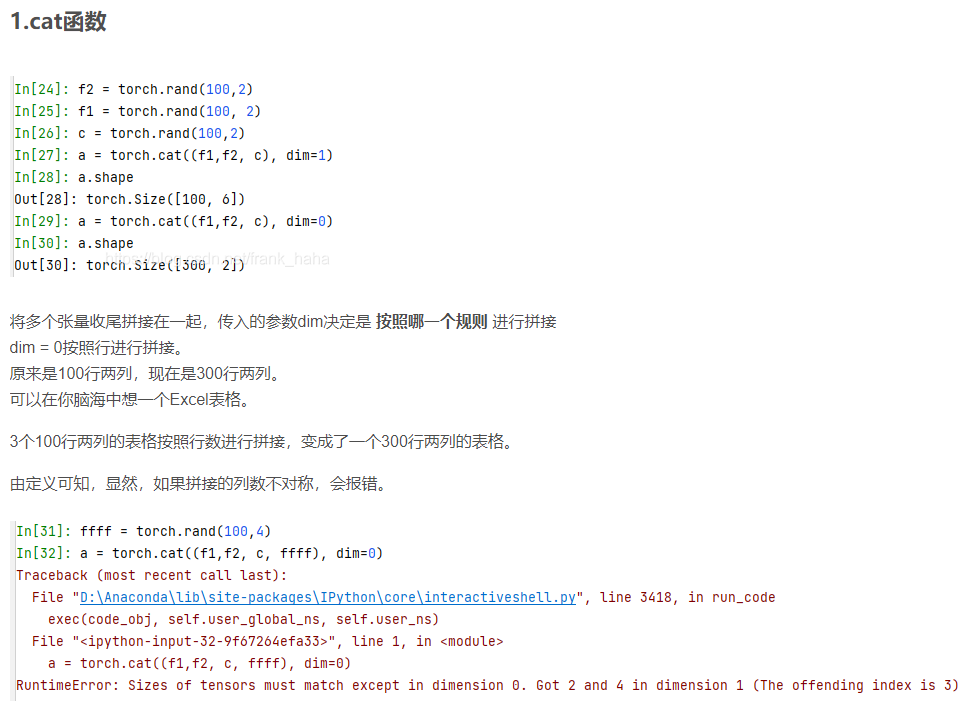
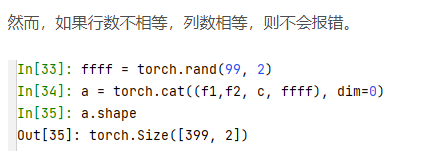
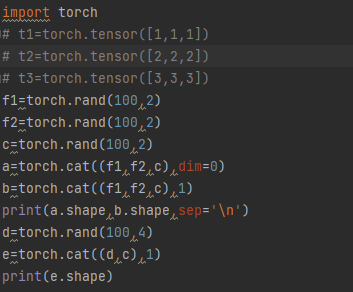
结果为:

上述行数相同d,c,在第一维度也即列上拼接时,能拼接成100行六列的tensor.
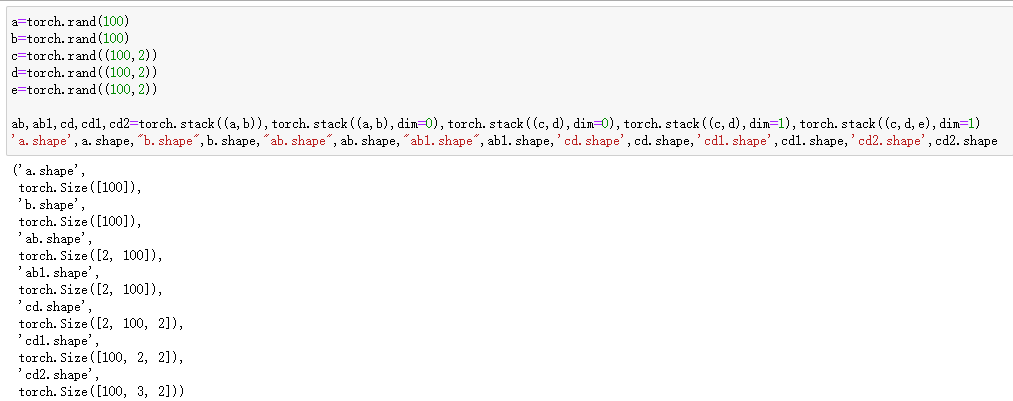
import torch a=torch.rand(100) b=torch.rand(100) c=torch.rand((100,2)) d=torch.rand((100,2)) e=torch.rand((100,2)) ab,ab1,cd,cd1,cd2,cd3=torch.stack((a,b)),torch.stack((a,b),dim=0),torch.stack((c,d),dim=0),torch.stack((c,d),dim=1),torch.stack((c,d,e),axis=1),torch.stack((c,d,e),dim=-1) 'a.shape',a.shape,"b.shape",b.shape,"ab.shape",ab.shape,"ab1.shape",ab1.shape,'cd.shape',cd.shape,'cd1.shape',cd1.shape,'cd2.shape',cd2.shape,cd3.shape
此处需注意的是:torch.stack((c,d,e),dim=-1)和torch.stack((c,d,e),dim=2)结果是一样的;
('a.shape',
torch.Size([100]),
'b.shape',
torch.Size([100]),
'ab.shape',
torch.Size([2, 100]),
'ab1.shape',
torch.Size([2, 100]),
'cd.shape',
torch.Size([2, 100, 2]),
'cd1.shape',
torch.Size([100, 2, 2]),
'cd2.shape',
torch.Size([100, 3, 2]),
torch.Size([100, 2, 3]))
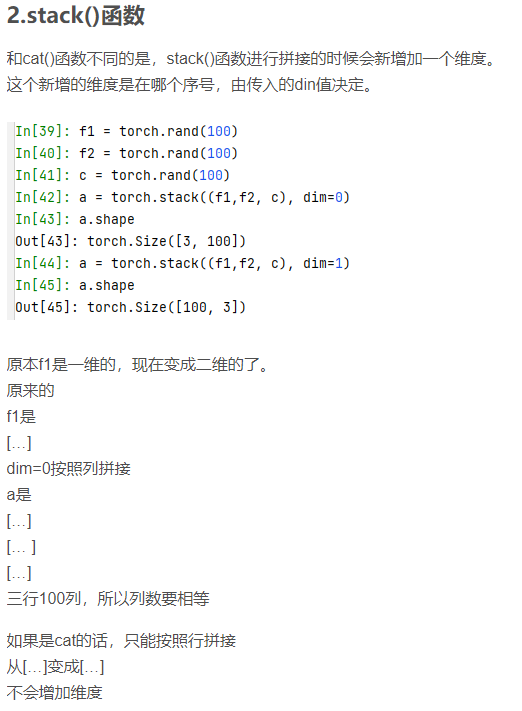
import torch
# t1=torch.tensor([1,1,1])
# t2=torch.tensor([2,2,2])
# t3=torch.tensor([3,3,3])
f1=torch.tensor([[1,2,3],[4,5,6]])
f2=torch.tensor([[7,8,9],[10,11,12]])
c=torch.tensor([[13,14,15],[16,17,18]])
# a=torch.cat((f1,f2,c),dim=0)
# b=torch.cat((f1,f2,c),1)
# print(a.shape,b.shape,sep='\n')
# d=torch.rand(100,4)
# e=torch.cat((d,c),1)
# print(e.shape)
g=torch.stack((f1,f2,c),0)
g1=torch.stack((f1,f2,c),1)
print(f1.shape,f2.shape,c.shape)
print('g: ',g.shape,g,sep='\n')
print('g1: ',g1.shape,g1,sep='\n')
输出结果为:
torch.Size([2, 3]) torch.Size([2, 3]) torch.Size([2, 3])
g:
torch.Size([3, 2, 3])#本来3个,就3个;本来2行3列就两行三列;只不过把他们放到一起,变成了3维的,多了一个维度;个人理解,可能有误。
tensor([[[ 1, 2, 3],
[ 4, 5, 6]],
[[ 7, 8, 9],
[10, 11, 12]],
[[13, 14, 15],
[16, 17, 18]]])
g1:
torch.Size([2, 3, 3])#把本来的三个中,每个的第一列拼在一块;第二列拼在一块;再把拼过后的第一列和第二列分别作为一个二维矩阵; 个人理解,可能有误。
tensor([[[ 1, 2, 3],
[ 7, 8, 9],
[13, 14, 15]],
[[ 4, 5, 6],
[10, 11, 12],
[16, 17, 18]]])
import torch
# t1=torch.tensor([1,1,1])
# t2=torch.tensor([2,2,2])
# t3=torch.tensor([3,3,3])
f1=torch.tensor([[1,2,3],[4,5,6]])
f2=torch.tensor([[7,8,9],[10,11,12]])
c=torch.tensor([[13,14,15],[16,17,18]])
# a=torch.cat((f1,f2,c),dim=0)
# b=torch.cat((f1,f2,c),1)
# print(a.shape,b.shape,sep='\n')
# d=torch.rand(100,4)
# e=torch.cat((d,c),1)
# print(e.shape)
g=torch.stack((f1,f2,c),0)
g1=torch.stack((f1,f2,c),2)
print(f1.shape,f2.shape,c.shape)
print('g: ',g.shape,g,sep='\n')
print('g1: ',g1.shape,g1,sep='\n')
输出结果:
torch.Size([2, 3]) torch.Size([2, 3]) torch.Size([2, 3])
g:
torch.Size([3, 2, 3])
tensor([[[ 1, 2, 3],
[ 4, 5, 6]],
[[ 7, 8, 9],
[10, 11, 12]],
[[13, 14, 15],
[16, 17, 18]]])
g1:
torch.Size([2, 3, 3])
tensor([[[ 1, 7, 13],
[ 2, 8, 14],
[ 3, 9, 15]],
[[ 4, 10, 16],
[ 5, 11, 17],
[ 6, 12, 18]]])
import torch
# t1=torch.tensor([1,1,1])
# t2=torch.tensor([2,2,2])
# t3=torch.tensor([3,3,3])
f1=torch.tensor([[1,2,3],[4,5,6]])
f2=torch.tensor([[7,8,9],[10,11,12]])
c=torch.tensor([[13,14,15],[16,17,18]])
# a=torch.cat((f1,f2,c),dim=0)
# b=torch.cat((f1,f2,c),1)
# print(a.shape,b.shape,sep='\n')
# d=torch.rand(100,4)
# e=torch.cat((d,c),1)
# print(e.shape)
g=torch.stack((f1,f2,c),0)
g1=torch.stack((f1,f2,c),3)#此处dim=3,或比3大的任何正数,都是如下报错结果。
print(f1.shape,f2.shape,c.shape)
print('g: ',g.shape,g,sep='\n')
print('g1: ',g1.shape,g1,sep='\n')
输出结果:
Traceback (most recent call last):
File "<input>", line 17, in <module>
IndexError: Dimension out of range (expected to be in range of [-3, 2], but got 3)
此外:
如果,torch.stack()的维度dim输入的是-1,-2,-3,也都可以正确输出结果。但是如果输入比-3小的任何数则会报错;具体如下:
import torch
# t1=torch.tensor([1,1,1])
# t2=torch.tensor([2,2,2])
# t3=torch.tensor([3,3,3])
f1=torch.tensor([[1,2,3],[4,5,6]])
f2=torch.tensor([[7,8,9],[10,11,12]])
c=torch.tensor([[13,14,15],[16,17,18]])
# a=torch.cat((f1,f2,c),dim=0)
# b=torch.cat((f1,f2,c),1)
# print(a.shape,b.shape,sep='\n')
# d=torch.rand(100,4)
# e=torch.cat((d,c),1)
# print(e.shape)
g=torch.stack((f1,f2,c),0)
g1=torch.stack((f1,f2,c),-1) #此时,维度是-1
print(f1.shape,f2.shape,c.shape)
print('g: ',g.shape,g,sep='\n')
print('g1: ',g1.shape,g1,sep='\n')
输出结果为:
torch.Size([2, 3]) torch.Size([2, 3]) torch.Size([2, 3])
g:
torch.Size([3, 2, 3])
tensor([[[ 1, 2, 3],
[ 4, 5, 6]],
[[ 7, 8, 9],
[10, 11, 12]],
[[13, 14, 15],
[16, 17, 18]]])
g1:
torch.Size([2, 3, 3])
tensor([[[ 1, 7, 13],
[ 2, 8, 14],
[ 3, 9, 15]],
[[ 4, 10, 16],
[ 5, 11, 17],
[ 6, 12, 18]]])
torch.stack()的维度dim输入的是--2;
输出结果为:
torch.Size([2, 3]) torch.Size([2, 3]) torch.Size([2, 3])
g:
torch.Size([3, 2, 3])
tensor([[[ 1, 2, 3],
[ 4, 5, 6]],
[[ 7, 8, 9],
[10, 11, 12]],
[[13, 14, 15],
[16, 17, 18]]])
g1:
torch.Size([2, 3, 3])
tensor([[[ 1, 2, 3],
[ 7, 8, 9],
[13, 14, 15]],
[[ 4, 5, 6],
[10, 11, 12],
[16, 17, 18]]])
torch.stack()的维度dim输入的是-3;
torch.Size([2, 3]) torch.Size([2, 3]) torch.Size([2, 3])
g:
torch.Size([3, 2, 3])
tensor([[[ 1, 2, 3],
[ 4, 5, 6]],
[[ 7, 8, 9],
[10, 11, 12]],
[[13, 14, 15],
[16, 17, 18]]])
g1:
torch.Size([3, 2, 3])
tensor([[[ 1, 2, 3],
[ 4, 5, 6]],
[[ 7, 8, 9],
[10, 11, 12]],
[[13, 14, 15],
[16, 17, 18]]])
import torch
# t1=torch.tensor([1,1,1])
# t2=torch.tensor([2,2,2])
# t3=torch.tensor([3,3,3])
f1=torch.tensor([[1,2,3],[4,5,6]])
f2=torch.tensor([[7,8,9],[10,11,12]])
c=torch.tensor([[13,14,15],[16,17,18]])
# a=torch.cat((f1,f2,c),dim=0)
# b=torch.cat((f1,f2,c),1)
# print(a.shape,b.shape,sep='\n')
# d=torch.rand(100,4)
# e=torch.cat((d,c),1)
# print(e.shape)
g=torch.stack((f1,f2,c),0)
g1=torch.stack((f1,f2,c),-4)#此处是dim=-4,小于-4的任何负数,输出类似的结果。
print(f1.shape,f2.shape,c.shape)
print('g: ',g.shape,g,sep='\n')
print('g1: ',g1.shape,g1,sep='\n')
输出结果为:
Traceback (most recent call last):
File "<input>", line 17, in <module>
IndexError: Dimension out of range (expected to be in range of [-3, 2], but got -4)
import torch a=torch.rand(100) b=torch.rand(100) c=torch.stack((a,b)) d=torch.stack((a,b),dim=0) e=torch.stack((a,b),dim=1) f=torch.cat((a,b)) f1=torch.cat((a,b),dim=0) # f2=torch.cat((a,b),dim=1)#错误提示:Dimension out of range (expected to be in range of [-1, 0], but got 1) c.size,c.size(),c.shape,d.shape,e.shape,f.shape,f.size(),f1.shape #从输出结果可看出,torch.rand(100)生成的是100行1列的数据,也即是一个列向量;concat沿着已有的维度拼接,stack在新创建的维度上拼接; #输出: (<function Tensor.size>, torch.Size([2, 100]), torch.Size([2, 100]), torch.Size([2, 100]), torch.Size([100, 2]), torch.Size([200]), torch.Size([200]), torch.Size([200]))



